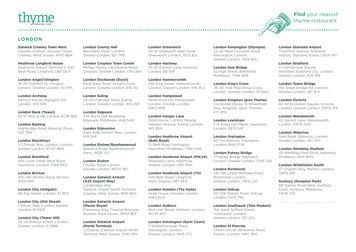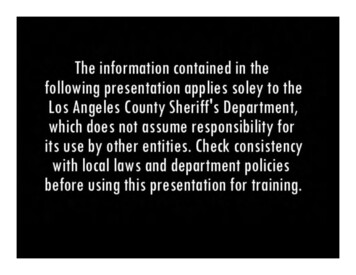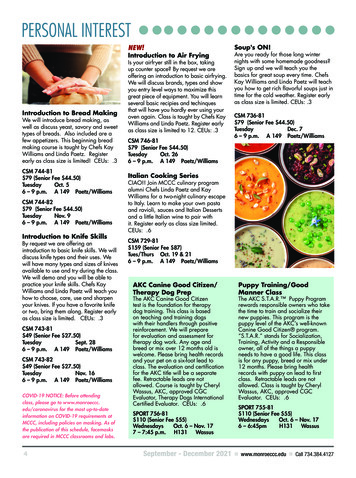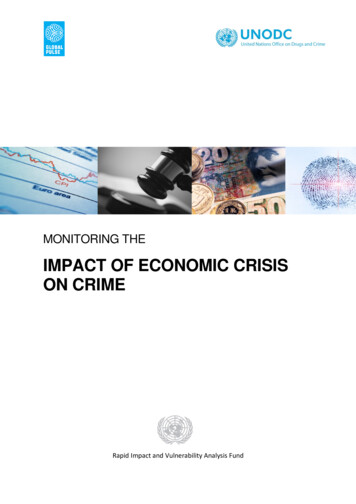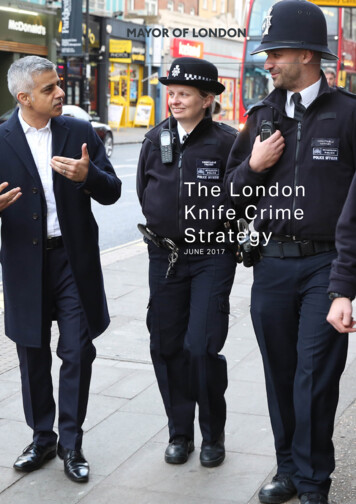
Transcription
The LondonKnife CrimeS t rategyJ UNE 2 0 1 7Date
T H E LO N D O N K N I F E C R I M E S T R AT E G YCopyrightGreater London AuthorityJune 2017Greater London AuthorityCity HallThe Queen’s WalkMore LondonLondon SE1 2AAwww.london.gov.ukenquiries 020 7983 4000
3ContentsForeword from the Mayor5Knife Crime in London9Delivering this Strategy21Taking action27Targeting lawbreakers29Offering ways out of crime43Keeping deadly weapons off our streets47Protecting and educating young people53Standing with communities, neighbourhoodsand families against knife crime63Supporting victims of knife crime69Measuring progress on knife crime75
T H E LO N D O N K N I F E C R I M E S T R AT E G Y
5Foreword - Sadiq Khan, Mayor of LondonAs we publish this Strategy, knife crimewith injury has been on the increasefor three years around the country. InLondon, dozens of families have beenbereaved; many more have seen theirloved ones severely injured. I know Ispeak for the overwhelming majorityof Londoners when I say that this isabsolutely unacceptable. It has to stop.Through this Strategy, we set out acomprehensive plan of partnershipaction to tackle the immediate threat tosafety posed by knife crime in London.But, important as it is, tackling theimmediate problem is not enough. Overthe last decade, we have seen knifecrime peak, trough and peak again inLondon. I refuse to accept that this isthe norm. If we are to make a lastingdifference, we must do more to get togrips with the deeper issues fuellingviolence and knife crime in our city.We value all of our citizens and thecontributions they make as a whole inmaking London the best city in the world.Our young citizens play a huge part ineverything that is great about London,they are vibrant and dynamic, innovativeand inspirational. We must ensure theyhave every opportunity to flourish andmake the most out of the wealth ofopportunities which London provides.We must not accept that crime andviolence is a foregone conclusion forany young person in London, regardlessof their circumstances. We will redoublepartnership efforts to divert youngpeople at highest risk of offending andvictimisation away from a life ruined bycrime and onto a better path.Our communities are sick and tired of thedamage being done by knife crime. Wehear their voices. In this Strategy we setout how we will support communities asthey stand up against knife crime, withnew funding for grass-roots communityactivities to protect their children anddrive out crime.We recognise that knife crime hurtsmore than just the person physicallyinjured, and that support servicesmust reach further. We are makinggreater investment in support for thevictims of knife crime, their families andwider communities.We support determined, targetedenforcement by the Metropolitan PoliceService (MPS) and partners like TradingStandards to get dangerous individualsand dangerous weapons off our streets.This includes greater Borough-ledactivity to catch knife offenders and todeter anyone thinking of carrying a knife.It includes new activity to target theonline sale of knives to young people,which must be addressed.
T H E LO N D O N K N I F E C R I M E S T R AT E G Y
7But we must not submit to a counsel ofdespair that some of our most troubledyoung people are beyond help. We willnot give up on them. We will expand ourwork to reach out to those caught upin crime and give them the skills, theresources and the confidence to get out.No one person or organisation hasall the answers to knife crime, and weembarked on producing this strategywith a clear ambition to involve as manyorganisations, groups, communitiesand individuals as possible – bringingtogether the expertise and passion ofpeople doing excellent work every dayto keep young people safe. The toughfunding situation for all organisationsunderlines the need for us to worktogether, making the most of what wehave at our disposal to make the biggestdifference we can for our children andyoung people. The Met have alreadyreduced costs by nearly 600m since2012-13 and the government’s currentfunding settlement requires them toreduce costs by roughly a further 400mby 2020-21. I am working hard withthe Met to deliver this through greaterefficiency and minimise the impact onfront line officer numbers. But this isbecoming increasingly difficult. Thepolice service in London needs to beproperly funded and I am making thiscase to Government.The Met are just one of many publicservices in this city that have sufferedmassive cuts, and we recognisethe challenges also faced by localauthorities, criminal justice partners,health services and charitable sectorpartners. We know we cannot relyon police, or even statutory servicesalone, to respond to knife crime.Communities, families, faith groups, themedia and cultural sectors; we all havea responsibility to encourage youngpeople to fulfil their potential and not tocarry and use weapons.I am grateful to everyone who has takenpart in the development of the Strategy,and I look forward to working together todeliver it.We must drive knife crime out of London.Together, we can do it.
T H E LO N D O N K N I F E C R I M E S T R AT E G Y
9Knife Crime in London
T H E LO N D O N K N I F E C R I M E S T R AT E G YWhat do we mean by knife crime?Since 2008, knife crime has beendefined as any offence that satisfiesboth of the following criteria: Is classified as an offence ofhomicide, attempted murder,assault with intent to cause harm,assault with injury, threats to kill,sexual offences (including rape)and robbery; Where a knife or sharp instrumenthas been used to injure, usedas a threat, or the victim wasconvinced a knife was presentduring the offence.Knife possession offences have beendefined as:How many knife crimes are there?Who are the offenders and who arethe victims?Knife crime is on the rise across thecountry. In 2016, London (excluding theCity) accounted for around three in tenrecorded knife offences nationally. 1In the 12 months to March 2017, over12,000 knife crime offences wererecorded in London. 2 In 2016 knife crimeacross England and Wales rose by 14 percent, compared to 11 per cent in London.The majority of knife crimes in Londonare related to street violenceand robbery.KNIFE CRIMEMPS recorded offencesApril 2010 - March 201713,33214,171 Having an article with bladeor point in a public place(including school);12,12211,37810,0799,6919,743FY 14-15FY 15-16 Threatening with a blade or sharplypointed article in a public place(including school); Possession of offensive weapon; Using someone to look afteran offensive weapon; Threatening with anoffensive weapon.FY 10-11FY 11-12FY 12-13FY 13-14FY 16-171. cordedcrime-open-data-tables2. Metropolitan Police Recorded Crime data 2016/17 withcomparisons to 2015/16
11Analysis of Metropolitan Police crimedata for 2016/17 indicates that 75 percent of victims of knife crime are maleand frequently aged less than 25 yearsof age. 3 Almost half of all victims of knifecrime were from BAME backgrounds.Those recorded as black ethnicityrepresented one in five of all victims ofknife crime in the last year. For offenders,almost ninety per cent were male andof those, 62 per cent were from BAMEbackgrounds.HOMICIDE In 2016/17 there were 110homicides across the capital. Of these,57 were identified as being fatal knifecrimes. This includes seven which weredomestic abuse related. The remaining50 victims were almost exclusively male.Almost a third of all female victims ofhomicide were victims of fatal knife crimein the last year. For male victims this wasmuch higher, with 57 per cent of all malevictims of homicides being victims offatal knife crime.Young BAME males were frequently thevictims of non-domestic abuse relatedfatal knife crime in that period, withalmost half of all victims of non-domesticknife homicide being black males agedbetween 15 and 24 years of age.3. MPS knife crime victims data 2016/17.4. 2016/17 accused data shows that almost 88% of knifecrime offenders who commit crime resulting in injury were male.Of these, 65% were described as BAMEVIOLENCE WITH INJURY Knife crimeswhere someone is injured as a result areincreasing across England and Wales. InLondon, in the twelve months to March2017 there were over 4,400 victimsinjured as a result of knife crime – fromslight injuries to serious, life threateningwounds. This is an increase of over 750victims compared to the precedingyear, or 20.5 per cent. During thisperiod, 49 per cent of victims of knifecrime resulting in injury were aged 24or younger. This represents over 2,000young people and an increase on thepreceding year of almost 25 per cent.BAME young males are disproportionallyaffected, with 6 in 10 young male victimsrecorded as from BAME backgrounds.More specifically, almost half of all youngmale victims of knife crime with injurywere of black ethnicity.Those who commit knife crime with injuryare predominantly described as male andfrequently from a BAME background. 4Of male offenders, over half weredescribed as black males aged under25 years of age. It is also recognisedthat there is a huge overlap betweenvictims and offenders, and that they arenot always to separate groups. Likewise,whilst ninety per cent of knife crimeoffenders are male, 10% are femaleand interventions and activity deliveredthrough the strategy must recognise therole of women and girls as offenders aswell as victims.
T H E LO N D O N K N I F E C R I M E S T R AT E G Y
13POSSESSION of weapon offences havealso increased in the most recent periodacross England and Wales. In 2016/17there were approximately 4,000 crimesrecorded in London, representing anincrease of almost 23 per cent on thepreceding year. As possession offencesare often identified through policeactivity targeting people suspectedof carrying a weapon, this may be anindication of greater police activityrather than an increasing prevalence inthis type of crime.Why are people carrying andusing knives?The majority of research conductedinto weapon carrying has pointed toself-defence and protection 5 as a keyreason why young people carry knives.Significantly, for people surveyed,protecting themselves from otherscarrying weapons was considered tooutweigh the risk of being caught bypolice. 6 However we also recognise thatthe decision to carry or use weaponsis often more complex – in many casesknives are carried not for protection butto intimidate others, to facilitate robbery,to deliberately injure or kill or simply forthe perceived power and status that thecarrying of a weapon provides.5. Lemos, 2004; Squires et al.,20086. Broadhurst et al. (2008)What do we meanby ‘habitual knifecarrier’?A habitual knife carrier isdetermined by the police as anyindividual that has come up at leasttwice as a suspect on the CrimeRecord Information System (CRIS)for Possession of an OffensiveWeapon / Knife / Bladed Article ora Knife Injury excluding DomesticAbuse offence in the last two years.AND;At least one of the above offencesis in the last 12 months unless thissubject has been in prison for aperiod in the last 12 months.
T H E LO N D O N K N I F E C R I M E S T R AT E G YIn May 2017, the Deputy Mayor forPolicing and Crime met young offendersat HMP Isis who had collectively beendirectly involved as both victimsand offenders of knife related injuryoffences, discharging of a firearm andother serious violent offences, andwere deemed to be amongst the mostprolific and high risk offenders withinIsis. Their view was that street robberywas a key reason why young peoplecarry a knife; stating many young peopleare exposed either directly or throughthe experiences of their peers to streetrobbery between the ages of 11 and 14.The statistics support this - Robbery –Personal Property (42%) and GrievousBodily Harm (34%) offences continue tobe the highest recorded categories ofKnife crime. This results in a perceptionof danger and risk amongst youngpeople and that they need to have a knifein order to protect themselves. Youngpeople are aware of the areas wherethey feel they will be at a greater riskof being hurt and stated that they willalways choose to be “safe rather thansorry” when asked if worried about beingcaught by the police.What is the relationship between gangsand knife crime?Research 7 has shown a greater likelihoodof carrying knives among gang memberscompared to non-gang members, with asignificant difference in the percentageof people carrying knives betweenthese two groups. A review of surveydata from the New English and WelshArrestee Drug Abuse Monitoring (NEWADAM) programme at various custodysuites across the country found highlysignificant differences in weapon7. McVie, 2010
15“ when considering our responses toknife crime in London, it is importantto understand that knife crime is muchmore than just gang related activity.”carrying between gang membersand non-gang members, with a greatertendency to carry weapons amonggang members.Recent data suggests that the majorityof knife crime is not gang-related. Gangflagged crime accounted for 5% of allknife crime with injury during 2016 –down from almost 9% in the precedingyear. However, gang-related knife crimesare usually of a more violent nature toother knife related offending and thatyoung black and ethnic minority malesare disproportionately affected by moreserious and violent forms of knife crime,where an injury has resulted from theoffence. Statistics show that the victimsof serious, gang motivated knife crimeare predominantly male (92 per cent),young (80 per cent under 25 years ofage) and from a BAME background.As such, when considering ourresponses to knife crime in London,it is important to understand that knifecrime is much more than just gangrelated activity; focusing exclusively ongangs is not going to solve or adequatelyimpact on our knife crime challenges inLondon; this Strategy also recognisesthat there has been a shift in offendingpatterns with a renewed emergenceof group related offending, a group ofindividuals who cannot be classifiedas being part of an organised group organg. It should also be recognised thatgang and group violence is often linkedto drug markets, and that stabbings andknife crime can be asociated with thecontrol of drug supply both within andbeyond London. These changing trendsin offending behaviour and patterns willcontinue to be monitored and respondedto, whilst never losing sight of gangrelated offending which continues to bea key priority.
T H E LO N D O N K N I F E C R I M E S T R AT E G YWomen, girls and knife crimeThis strategy targets girls and youngwomen who carry and use knivesalongside their male counterparts.However there are significantproportions of knife crime whichaffect women and girls in the contextof abuse and violence within thehome and interpersonal relationships.The Mayor’s Violence Against Womenand Girls (VAWG) Strategy will addressacts of violence and harm perpetratedin the context of domestic abuse andother forms of VAWG which may involveknife crime.In December 2016, the Femicide CensusReport, published by Women’s Aidanalysed trends in women killed thoughintimate partner violence over sevenyears. The findings demonstrated thatwomen who experience domestic abuseare at a significantly higher risk to knifecrime and, sadly, often within their ownhomes. 88. g-and-influencing/femicide-census/9. andwales/yearendingmarch201610. Police and Crime Plan 2017-2021We know that Domestic Abuse is vastlyunder reported. Estimates based onthose interviewed in the Crime Surveyfor England and Wales during the yearending March 2015 showed that around4 in 5 victims (79%) of partner abuse didnot report the abuse to the police. 9 Thisimplies that there are many unreportedknife crime incidents happening withinthe home.
17In order to effectively bring perpetratorsof domestic abuse related knife crime tojustice, there needs to be an adequaterisk-assessment process that recordsthe use of knives/sharp weapons in adomestic violence incident and ensuresthere are significant consequences forsuch action. MOPAC will work with theCrown Prosecution Service and thejudiciary to ensure that the severity ofthreats of violence (typically with a knife)is taken into account when prosecutingperpetrators of domestic abuse, or whenconsidering criminal and civil courtorders or restraining orders.MOPAC and NHSE, along with partners,are using the findings from theconsultation for this Strategy and theNeeds Assessment to explore futurecommissioning of services to supportvictims of CSE.Knife crime andChild Sexual Exploitation (CSE)The night time economy is a key driver ofeconomic and cultural regeneration anda magnet for domestic and internationalvisitors. Recent research shows that thenight time economy contributes 26.3bnto London’s annual GDP and supports 1in 8 jobs. 10 This figure is expected to riseto 28.3bn by 2029.MOPAC and NHS England (London)commissioned a Needs Assessmentof Child Sexual Abuse and Exploitationpublished in 2016 which aimed toestablish the level of CSE in Londonand the scale of the need for supportservices. Whilst the Needs Assessmentdid not identify the use of knives as amajor issue in relation to CSE, it wasreported during the consultation forthis strategy that there are increasingconcerns with regards to the linkbetween sexual violence committedby and against young people andthe increased carrying and use ofknives, putting young women at evengreater risk.Delivery against these priority areas willtherefore sit outside of this strategicKnife Crime Strategy, which is targetedtowards preventing and reducing knifecrime affecting young Londoners.Knife crime and theLate Night EconomyAnalysis of the locations of knife crimeshows some cross over with areas linkedto London’s night time economy, suchas areas in central London. However,more work is needed to understand ifthese are directly linked or that this isa key driver of knife offending. Throughfurther analysis we are seeking to gaina greater understanding of any impactknife crime has in areas related to thenight time economy.
T H E LO N D O N K N I F E C R I M E S T R AT E G Y
19What do Londoners think aboutknife crime?Londoners are highly unlikely to bevictims of knife crime, but knife crimeaffects us all, our sense of communityand our feelings of safety on our streets.Findings from the MOPAC Public AttitudeSurvey (FY 16/17) indicate that 19.7%of Londoners perceive knife crime to bea problem in their local area. Within thisthere is borough variation – WalthamForest has the highest perceivedconcern (34.9% view as a problem), whileBromley has the lowest (4.8% view as aproblem) 11. Younger respondents (under25) are most likely to feel that knife crimeis a problem in their area, while thoseover 65 are least likely to feel it is aproblem.In line with the findings of our researchand consultation, this Strategy focusestackling non-domestic, high harmknife crime which is perpetratedagainst young people, under the ageof 25, targeting resources to our mostvulnerable locations and Londoners; toour geographical locations most at riskof being affected by knife crime and tothose communities and Londoners mostlikely to be directly involved or impactedby knife crime.We also recognise that other weaponsare used to cause harm. Firearms,bottles, and even acid can be used asa weapon, but we are also mindful thatthe volume of harm caused by knivesin London is significant and so must betargeted and addressed. We will keepthis under review however, and shouldit be necessary add to the delivery planfor the strategy to incorporate otherweapons. This strategy aims to preventviolence overall – no matter what theweapon of choice might be.11. The MOPAC Public Attitude Survey is a large scale representativesurvey of London, interviewing 12,800 Londoners per annum.
T H E LO N D O N K N I F E C R I M E S T R AT E G Y
21Developing and delivering this Strategy
T H E LO N D O N K N I F E C R I M E S T R AT E G YThe challenges in delivering this strategycannot be overstated and even with allthe powers of the Mayor and the police,knife crime will not reduce without allpartners and communities in Londonpulling together to make changes andimprovements. Arresting, sentencing,and even rehabilitating offenders willnot stop knives being accessible on thestreets and nor will it stop young peoplemaking the choice to carry and knifefor the first time. For long term changewe need parents and families, schoolsand youth groups, and communitiesto come together to discourage andprevent knife carrying, as well as themedia, businesses and other influencersto do their part to make spaces whereyoung people spend their time – online,at school, town centres, outdoors and athome – safe.OversightThe Mayor is responsible for agreeingthe Police and Crime Plan for London,agreeing the MPS budget and overseeingthe performance of the MPS. Hedelegates most of these powers to theDeputy Mayor for Policing and Crime, whois supported in her work by the Mayor’sOffice for Policing and Crime (MOPAC).The Deputy Mayor for Policing and Crime,supported by MOPAC, will continueto provide robust scrutiny of the MPSresponses to knife crime, drivingforward performance and holding theCommissioner to account through herregular oversight meetings with the MPS.Strategic risks of both MOPAC and theMPS receive scrutiny and challenge fromthe independent MOPAC/MPS AuditPanel. The Audit Panel is responsible forenhancing public trust and confidence inMOPAC and the MPS.ConveningPartnership is central to the delivery ofthis strategy – no one organisation hasthe ability to solve the problem of knifecrime alone. The Mayor has a uniqueconvening power in London. Agencies inthe criminal justice sector and beyondlook to the Mayor to provide leadershipand to bring organisations together tostrengthen partnerships. In tackling knifecrime, we are using this power to bringtogether all of our partnersWe convene partners at the LondonCrime Reduction Board to drive jointworking with the most senior officers
23from across the Criminal Justice Serviceand to influence key strategy decisions.Where we need to, we will challengepartners, advocate and call for action onpriority issues to make sure we get thebest services for Londoners.This Strategy has been developedin close co-operation with the MPS,partner agencies and communities.We’ve consulted and surveyed hundredsof young people, professionals, andcommunity partners to inform thecommitments. We have had a particularfocus on ensuring the strategy isinformed by the ‘youth voice’, and assuch we hosted specific events totarget young people, including a youthroundtable event, workshops withyoung offenders in HMP Isis prison, andthose on community orders under thesupervision of youth offending teams, inaddition to a Big Talk event with youngpeople. We’ve surveyed 400 youngpeople in the areas most affected byknife crime in London and also used thefindings from over 700 16-24 year oldswho were surveyed in the Talk Londonsurvey in the development of the Policeand Crime Plan.A multi-agencypartnershipapproachRecognising that there waslittle support available for youngvictims of crime, The LewishamYoung Victims’ Multi-Agency RiskAssessment Conference (YouthMARAC) was established in May2009 to increase young people’sconfidence and trust in keyagencies. Facilitating multi-agencyinformation sharing fora and actionplanning to protect youngpeople at risk of harm, the projectpresents a pioneering approachto supporting and protecting youngvictims of crime.This work has been developedfurther and Lewisham now operatesboth a Serious Youth CrimePrevention Panel (SYCPP) and aMissing Exploited and Trafficked(MET) process.
T H E LO N D O N K N I F E C R I M E S T R AT E G YParticipants in the consultation include:The MPS, The Crown ProsecutionService, HM Prisons and ProbationService, HM Courts and TribunalsService, the London CommunityRehabilitation Company, LondonCouncils, the Home Office, the Ministryof Justice, NHS England, the London FireBrigade, Victim Support, London Headsof Community Safety, Trading Standards,the Youth Justice Board, London Headteachers, Vicky Foxcroft MP, Ofsted, theLondon Assembly, the London Stop andSearch Community Network, Stopwatch,Safer Neighbourhood Boards, City SafeHavens, New Beginnings, Ganglines,Chance UK, Growing Against Violence,London Youth, the Godwin LawsonFoundation, Groundwork, St Matthew’sProject Brixton, Hackney Quest,Bankside Residents Forum, FootballBeyond Borders, Coin Street CommunityBuilders, the Crib, Barnardos, Leadersin Community, Rugby Portobello Trust,the Safer London Foundation, the OasisTrust, Gang Conflict Mediation, YoungLambeth, Gascoyne and MorningsideYouth Clubs, the Damilola TaylorFoundation, South Central Youth, EpicLearning, Edukit, Educational Excellence,Leap Confronting Conflict, Redthread,St. Giles Trust, Catch 22, LVSC, Box UpCrime, the SOLA Foundation, the Prince’sTrust, Hyde Housing, Spark 2 Life, HoxtonHall, Misunderstood, Lewisham Council,Transport for London, SouthwarkCouncil, Camden Council, ShoutOut UK, Kiyan Prince Foundation,Ofsted, Ben Kinsella Trust, ChildLine,Word 4 Weapons, Josh Hanson Trust,MAC UK, Parent Voice, Evolve Housing,Fight for Peace, The Flavasum Trust,Rise Empowerment, Cherry TreeFoundation, Working Chance, GangsLine, Mother, Jags Foundation, Anti KnifeUK, Inspired Futures, Lambeth Council,Edmonton County School.Inclusion and involvement are at theheart of our approach to our work,and we will continue to engage withcommunities and stakeholders, buildingrelationships and working together to ridour city of knife crime.
25DeliveryMOPAC commissions a range of services,and provides funding and support toa wide range of crime reduction andcommunity safety projects in London.For the first time, the Mayor’s fundingfor victims’ services across the capital,previously provided on an annual basis,has been allocated for three yearsto provide longer-term support. Theinvestment of 47 million over thePolice and Crime Plan period will helpimprove current work and commissionnew services, including developing acollaborative ‘one-service’ approachrather than the current system whichsees a victim or witness dealing with aconfusing number of different agencies.Within this funding, 2m has beenallocated to increase support foryoung victims of crime - including knifecrime - and their families. The changein funding delivery will allow flexibilityfor MOPAC to respond to changingdemands and deliver the Mayor’scommitments to do more in areasincluding restorative justice.Through the London Crime PreventionFund, the Mayor has committed 72mover the Police and Crime Plan periodto support projects across Londondedicated to preventing crime, including 5m spent on projects tackling youthcrime, gang crime, and knife crime.This new London Crime PreventionFund settlement is awarded accordingto the greatest need across London’sBoroughs, with a new emphasis onensuring every Londoner has theaccess to the services they need tohelp support them and keep them safe,in line with the principles of the Policeand Crime Plan. Furthermore, somefunds will be redirected to supportjoint commissioning of services acrossBoroughs, helping to facilitate theprovision of specialist services thatneed a greater economy of scale thancan be provided by one Borough alone.Local Authorities are core partners inthe development of this new fundingpot, which accounts for 30 per cent ofthe LCPF budget from 2018/19 onwards.This Strategy is backed by a furtherinvestment of 625k by the Mayor,taking the total spending by the Mayor’sOffice for Policing and Crime on knifeand gang crime projects to more than 7m per year.Across all our commissioning for thisStrategy, we will take a trauma-informedand culturally competent approach,and we will be ensuring that serviceusers and young people are engaged.Importantly, we will continue our gripon ensuring we secure genuine valuefor money. We want to be assured thatthe taxes paid by Londoners are beingused as efficiently as possible. Wewill continue to make this happen withrigorous funding application processesand robust contract management.
T H E LO N D O N K N I F E C R I M E S T R AT E G Y
27Taking action01 .TARG E T IN G L AW BR E A K E RS02 .O F F E R IN G WAYS O UT O F CRI M E03 .KE E P IN G DE A DLY W E A PONS O FF OU R STRE E T S04 .P ROT E CT IN G A N D E DUCATI NG YOU NG PEO PLE05 .STA N DIN G W IT H C O M M U NI TI E S, NE I G HB OU RHOODSAND FA M IL IE S AG A IN ST K NI FE CRI M E06 .SU P PO RT IN G V ICT IM S OF K NI FE CRI M E
T H E LO N D O N K N I F E C R I M E S T R AT E G Y“Our fight againstknife crime is ingrainedin our neighbourhoodpolicing and runsthrough everything wedo. From our diversionschemes, and gangenforcement,to our protectionof vulnerable peopleand our partnershipwith schools.“Cressida Dick,Commissioner of theMetropolitan Police Service
29TARGE T I NG L AW BR E A K E R S :POLICINGAs we have seen with the recenttragic events in London, the demandfor an efficient, dynamic and responsivepolice service in the capital has neverbeen greater, and community policingis the foundation of all our efforts toprotect our city. There is no substitutefor visible officers out on the beat inneighbourhoods. They are the eyesand ears of policing – helping to detectand prevent crime, and build trustand confidence.Vital to our mission of making Londona safer city for all, is ensuring thatthe Metropolitan Police Service hasthe funding it needs. As a result ofgovernment funding reductions, the MPShas made 600m in savings since 2010,and has a further 400m to save over thenext four years. This will be extremelychallenging. The Mayor and MOPACcontinue to
crime and onto a better path. Our communities are sick and tired of the damage being done by knife crime. We hear their voices. In this Strategy we set out how we will support communities as they stand up against knife crime, with new funding for grass-roots community activities to protect their children and drive out crime.




